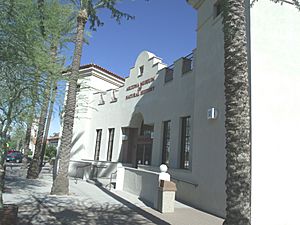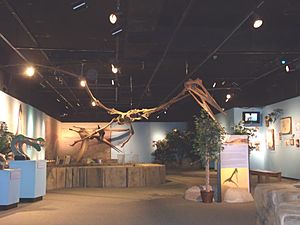Arizona Museum of Natural History facts for kids

Main entrance of the Arizona Museum of Natural History
|
|
| Established | 1977 |
|---|---|
| Location | Mesa, Arizona, United States |
The Arizona Museum of Natural History is a super cool place in Mesa, Arizona. It's the only natural history museum in the big Phoenix area. This museum shows off the amazing natural world and the history of people in the Southwestern United States.
Contents
History of the Museum
The Arizona Museum of Natural History started small in 1977. It was first called the Mesa Southwest Museum and was located in the Mesa City Hall. This building was built in 1937 with help from a government program. It used to house many city offices, like the library and police department.
The museum grew bigger over the years. New parts were added in 1983, 1987, and 2000. Today, the main museum building is huge, with lots of space for exhibits. It holds a collection of 60,000 items, including old photos, natural history objects, and cultural artifacts. In 1995, a special research area was added. Here, experts study paleontology (fossils) and archeology (ancient cultures).
In 2007, the museum got its new name, the Arizona Museum of Natural History. Lots of people visit every year, usually around 140,000!
Awesome Museum Exhibits
The museum has many exciting exhibits to explore. One of the most popular is Dinosaur Mountain, which has a three-story indoor waterfall! You can see moving, lifelike dinosaurs there. There's also a cool flash flood display that happens every 30 minutes.
Dinosaur Hall and More
In the Dinosaur Hall, you'll find incredible dinosaur skeletons. You can also see a real old-time jail from Arizona's early days. Another fun exhibit is a recreation of the famous Lost Dutchman's Gold Mine.
Southwest Gallery: Native Peoples
The Southwest Gallery teaches you about the native peoples of the area. You can learn about the first people in North America, who were big game hunters and gatherers. There are also exhibits about later desert cultures. A special part of this gallery is a recreated Hohokam village. It shows how people lived from about A.D. 600 to 1450, with pithouses and other buildings filled with real artifacts.
Ancient Cultures and Origins
Another exhibit explores the Ancient Cultures of Mexico. The Origins gallery takes you on a journey through time. It shows the history of the universe and important events on Earth.
Hands-On Fun
The museum also has interactive areas. The Exploration Station is a hands-on area where you can learn by doing. There's also a Paleo Dig Pit where you can pretend to be a paleontologist and dig for fossils!
Past Special Exhibits
The museum often has new, temporary exhibits. One popular past exhibit was "Rulers of the Prehistoric Skies." This exhibit helped answer questions about how flight evolved. It focused on pterosaurs, which were flying reptiles. These amazing creatures were the first vertebrates (animals with backbones) to fly! They had unique, hollow bones and flexible wings.
This exhibit showed how different pterosaurs were. Volunteers even built models, like a 4-foot mechanical pterosaur called "Clam Digger." A stunning life-size sculpture of a Pteranodon sternbergi by artist Ed Mack still hangs over Dinosaur Mountain. "Rulers of the Prehistoric Skies" opened in February 2012 and was so popular it stayed for about four years!
Another past exhibit was "The Primal Desert Next Door: Land of Black Volcanoes and White Sands." This exhibit, open from February 2011 to January 2013, explored the Sonoran Desert in Mexico. It showed the unique landscapes, like dark volcanic fields and bright sand dunes. Visitors learned about the geology, flora (plants), and fauna (animals) of this region through photos and interactive displays. There was even a "dune machine" and a mock lava tube for kids to climb through!
The museum's special exhibits are often supported by donations from the Arizona Museum of Natural History Foundation.
Sirrine House
The museum also takes care of the Sirrine House. This beautiful Queen Anne style home was built in Mesa in 1896. It's the only fully restored Victorian-era home museum in the area. The Sirrine House is usually open for special events.
Paleontology: Studying Ancient Life
The Paleontology Section is a big part of the museum's Natural History focus. Paleontology is the study of past life, especially fossils. The museum's experts explore, dig up, prepare, and research fossils. They work with different agencies and are an official place to keep fossils found in Arizona.
Dinosaur Hall Highlights
In the Dinosaur Hall, you can see many cool fossils. There's a "Zuni coelurosaur," a Tarbosaurus skeleton, and a Tyrannosaurus rex skull. You might also spot a Gastornis. For long-necked dinosaurs, they have a Camarasaurus skeleton and an Apatosaurus femur (leg bone). Horned dinosaurs include a Psittacosaurus skeleton, a Zuniceratops, Protoceratops, Pentaceratops, and Triceratops. There's also a Probactrosaurus, which is a type of iguanodont.
Archeology and Anthropology: Human History
The Anthropology Section at the museum studies human cultures. They do research and create exhibits about Native American cultures and the history of southern Arizona. Archeology has been important to the museum since it started.
Mesa Grande Ruin
A major project for the anthropology department is the ongoing excavation at the Mesa Grande Ruin. This is a large mound in Mesa that dates back to the Hohokam people from the Classic Period. A main goal of the museum is to open Mesa Grande as a place where the public can learn about the Hohokam and O'odham people.
Images for kids
See also
 In Spanish: Museo de Historia Natural de Arizona para niños
In Spanish: Museo de Historia Natural de Arizona para niños


















